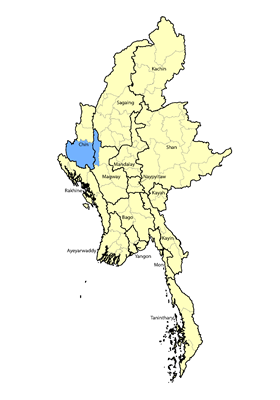The Rawngtu have been overlooked in the ethnic history of Myanmar until recently. The 1931 census listed them under the name Welaung. Although this showed that the British were aware of their existence, mysteriously, no population was entered for them. The outside world became aware of the Rawngtu people after linguists began studying their language in the new millennium. Today, the Rawngtu are glad to be known as a distinct people group and language, different from all other Chin tribes in Myanmar.
Location: Numbering approximately 5,600 people, the Rawngtu tribe inhabits ten villages in western Myanmar, with most residing within Matupi and Mindat townships in Chin State. A lesser number of Rawngtu families live further east across the state border in the Magway Region. Rawngtu territory is bordered by several Chin tribes, with the Zotung immediately to the north, the Matu to the west, Kaang to the south, and Cho to the east. This remote area is characterized by densely forested mountains that are separated by fast-flowing rivers and streams.
Language: Rawngtu, which is also known as Welaung, consists of four dialects, each of which may represent a distinct people group. The dialects share a 90 percent lexical similarity with each other, meaning that nine out of ten words in each dialect appear to come from the same linguistic root, with the Kyonnam dialect being the most widely spoken. Studies that compare Rawngtu with other Chin varieties found it shares a lexical similarity of 84 percent with Matu, 67 percent with Kaang, and less than 70 percent with Taungtha. These percentages are too low to allow for mutual communication. Many Rawngtu people are fluent in Burmese and in Muun, which is spoken by the large Cho tribe immediately to the east. Rawngtu did not have a written form until a script was created by Baptist Pastor Reng Toi at the start of this century.
In the past, the Rawngtu were part of the larger Taungtha ethnic group, who now live wholly across the state border in the Magway Region. The two groups probably diverged due to religious differences, with the Taungtha being Buddhists while the Rawngtu converted to Christianity. For generations, tribes in this remote part of Myanmar constantly waged war with one another, but today the Rawngtu lead simple lives as agriculturists in their beautiful homeland.
The Rawngtu were previously one of the Chin tribes that tattooed the faces of young women at puberty, although the practice has been outlawed since the 1960s. Several theories regarding the origin of face tattooing exist, but one of the more plausible ones says: “Their women were very handsome, and many of them were therefore captured for the king’s harem, and the custom originated to prevent this calamity.”
The Rawngtu people experienced a dramatic and all-encompassing movement to Christ during the 20th century, when almost their entire population went from being animists to following Jesus, although a small number of rural families still cling to spirit worship.
Although practically all Rawngtu people declare faith in Jesus Christ today, the only Scriptures translated into their language are portions from the Gospels of Matthew and Luke that were printed in 2001. In the Magway Region, the Methodist Missionary Society commenced work at Pakokku in 1888, although it is not known if they targeted the Rawngtu who live there. In the last 25 years a major rift developed among Rawngtu Christians when the established Baptist churches were joined by a new denomination called the Church of the Living God, causing a deep schism in the Rawngtu society. A 2011 study lamented: “Unity has been weakened by the rift between the Baptist Church and the Church of the Living God. They will need to rebuild unity before a language development project will be able to succeed among them.”
Scripture Prayers for the Rawngtu in Myanmar (Burma).
| Profile Source: Asia Harvest |











